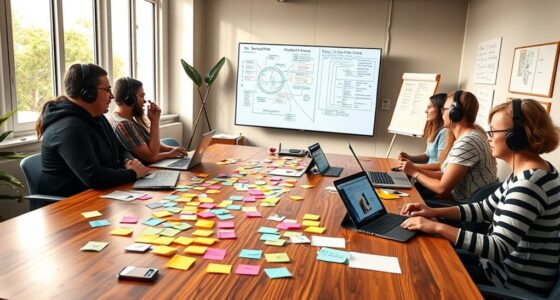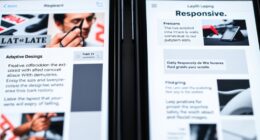Design thinking is a human-centered approach that guides you through five key stages to solve problems creatively. You start by empathizing to understand users’ needs and frustrations. Then, you define the core issue from their perspective. Next, you brainstorm innovative solutions and quickly build prototypes. Finally, you gather feedback to refine and improve your ideas. Continuing to explore each stage helps you unbolt effective, user-focused solutions that truly make a difference.
Key Takeaways
- Design thinking is a user-centered approach to problem-solving that emphasizes understanding user needs and experiences.
- It involves five stages: Empathize, Define, Ideate, Prototype, and Test, to develop innovative solutions.
- The process encourages creativity, collaboration, and rapid iteration to refine ideas based on user feedback.
- It aims to address complex problems by framing them from the user’s perspective and testing solutions early.
- Design thinking promotes empathy, open-mindedness, and continuous improvement throughout the design process.
Empathize: Understanding Users and Their Needs

Have you ever wondered what your users truly need? Empathizing is all about stepping into their shoes and understanding their experiences, frustrations, and desires. You need to listen deeply and observe carefully, not just assume what’s best for them. Conduct interviews, shadow users, and gather insights that reveal their real pain points. Remember, users may not always articulate their needs directly, so your job is to interpret their behaviors and emotions. By immersing yourself in their world, you gain valuable perspectives that can guide your design process. This stage isn’t about solutions; it’s about building a genuine connection and understanding what truly matters to your users. Incorporating customer insights from various touchpoints enables a more comprehensive understanding of user needs. Recognizing the importance of emotional resilience can help you better appreciate how users cope with challenges and stressors, leading to more empathetic solutions. Understanding market trends and insights allows you to see broader influences on user behaviors and preferences, enriching your empathy efforts. Engaging with diverse teams during this process broadens your perspective and fosters more inclusive, user-centered designs. Developing a strong sense of empathy allows you to connect more deeply with users’ experiences, fostering trust and better solutions. When you empathize effectively, you set a solid foundation for creating meaningful, user-centered solutions.
Define: Framing the Right Problem

Once you’ve gained a deep understanding of your users’ needs through empathy, the next step is to clearly define the problem you’re solving. This involves synthesizing your insights into a clear problem statement that guides your design process. Focus on framing the issue from the user’s perspective, highlighting their pain points and unmet needs. Avoid jumping to solutions too early; instead, concentrate on understanding the core challenge. Use tools like “How Might We” questions to keep your problem open-ended and inspiring. Defining the right problem ensures your team stays aligned and focused on impactful solutions. A well-framed problem sets the foundation for innovative ideas that truly address user needs. Incorporating content analysis can help identify underlying patterns and themes in user feedback, leading to more accurate problem framing. Additionally, considering home decor elements like wall organization or dinnerware styles can inspire creative problem statements that enhance user environments. Recognizing the importance of safe sleep environments can also guide the development of solutions that improve infant sleep quality and parental peace of mind. Understanding how juice cleansing and detox practices relate to health can further inform user-centered problem framing, especially when addressing wellness challenges.
Ideate: Generating Creative Solutions

How can you generate a wide range of innovative ideas to solve the defined problem? Start by brainstorming freely, without judgment or limitations. Encourage diverse perspectives, involving team members from different backgrounds to spark fresh insights. Use techniques like mind mapping, where you branch out from a central idea, or SCAMPER, which prompts you to Substitute, Combine, Adapt, Modify, Put to another use, Eliminate, or Rearrange elements. Quantity matters—aim for many ideas, knowing that the best solutions often emerge from this pool of possibilities. Embrace wild ideas and build on each other’s suggestions. Remember, the goal is to think creatively and broadly, breaking free from conventional thinking to discover innovative solutions that truly address the problem. Additionally, exploring best anime movies can inspire creative storytelling approaches in your design process.
Prototype: Building Tangible Concepts

Turning your creative ideas into tangible forms is the next essential step in the design thinking process. This is where you transform abstract concepts into physical or digital prototypes that you can test and refine. To do this effectively:
- Select the most promising ideas and develop simple models or mockups.
- Use inexpensive materials or digital tools to create quick, workable versions.
- Focus on core features to communicate your concept clearly without overcomplicating.
Prototyping allows you to explore how your ideas function in real-world scenarios. It helps identify problems early and sparks new insights. Remember, your goal isn’t perfection but creating a tangible representation that encourages feedback and improvement. This hands-on approach accelerates innovation and brings your vision closer to reality.
Test: Refining Ideas Through Feedback

Have you ever wondered why feedback is essential in the design thinking process? It helps you identify strengths and weaknesses of your ideas, guiding improvements. When testing, you gather real user responses, revealing unforeseen issues or needs. This stage isn’t about perfection but refinement. To visualize, imagine this table:
| Feedback Focus | Outcome |
|---|---|
| User experience | Identify pain points |
| Functionality | Discover missing features |
| Visual appeal | Enhance aesthetics and clarity |
| Overall satisfaction | Strengthen engagement and value |
This feedback loop keeps you aligned with user needs, ensuring your solution evolves into a more effective, user-centered design. Embracing honest critiques helps you iterate confidently and create impactful results. Additionally, understanding how to maximize your tan during testing can help you evaluate the comfort and effectiveness of your design under real-world conditions. Proper privacy management ensures that user data collected during testing remains secure and respectful of user rights. Recognizing the importance of emotional support can also inspire creative approaches to sensory feedback and user comfort in your designs. Incorporating usability testing early and often allows for continuous improvement and refinement.
Frequently Asked Questions
How Does Design Thinking Differ From Traditional Problem-Solving Methods?
You might notice that design thinking differs from traditional methods because it focuses on empathy, collaboration, and experimentation. Instead of just analyzing problems and applying fixed solutions, you actively engage with users, brainstorm creatively, and test ideas quickly. This iterative process encourages flexibility and learning from failures, making it more adaptive and user-centered than conventional problem-solving, which often emphasizes linear, analytical approaches.
Can Design Thinking Be Applied Outside of Product Development?
Imagine walking into a cluttered kitchen, needing to organize it. You can apply design thinking here by empathizing with your needs, brainstorming creative storage solutions, and prototyping ideas. It’s not just for products; you can use it in any challenge—whether redesigning your workspace or planning a community event. By focusing on human needs and iterative solutions, you turn complex problems into manageable, innovative outcomes, no matter the context.
What Industries Benefit Most From Design Thinking?
You’ll find that industries like healthcare, education, and finance benefit most from design thinking. It helps you solve complex problems by focusing on user needs and innovative solutions. By applying a human-centered approach, you can improve patient experiences, create engaging educational tools, or develop more accessible financial services. This adaptable method encourages collaboration and creativity across sectors, making it a powerful tool for driving positive change and efficiency.
How Long Does a Typical Design Thinking Process Take?
You’re probably wondering how long a typical design thinking process takes. Well, it varies depending on your project’s complexity, but generally, you can expect it to last anywhere from a few days to several weeks. Smaller projects move quickly, while larger, more intricate challenges may require months of iteration. The key is to stay flexible, adapt as needed, and remember that rushing can compromise the innovative results you’re aiming for.
What Are Common Challenges When Implementing Design Thinking?
When implementing design thinking, you might face challenges like resistance to change, as team members may cling to familiar methods. You could also struggle with ambiguity, since the process encourages experimentation and iteration. Additionally, aligning stakeholders’ diverse perspectives can be tough, leading to conflicting priorities. Finally, time constraints might hinder thorough exploration, but staying open-minded, fostering collaboration, and clearly communicating goals can help you overcome these common obstacles effectively.
Conclusion
By embracing these five stages, you can create innovative solutions that truly meet user needs. Did you know that companies using design thinking see a 20% increase in customer satisfaction? When you empathize, define, ideate, prototype, and test effectively, you turn ideas into impactful results. So, start applying these steps today—your next great innovation is just a mindset away.









